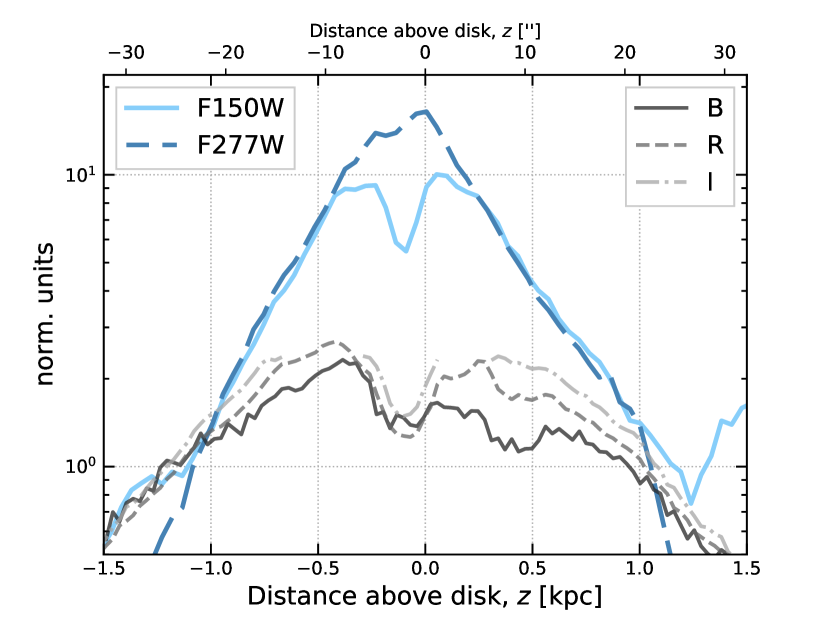Some galaxies get all the attention. This is often simply because it was the easiest to observe to begin with, nice and close, fit in the telescope’s viewer or told us something interesting thanks to our perspective.
In the case of NGC 891, it is all of the above. Easily seen from the Northern Hemisphere, it was the subject of a bunch of studies on the thickness of disk galaxies. It is perfectly edge-on and pretty close.

The vertical structure of galaxies is a subject unto its own. Why are disk galaxies so flat? What can we learn from the interstellar medium in these disks by studying from the side? My PhD advisor Piet van der Kruit used this galaxy to formulate how to describe the light distribution of galaxies for the first time back in 1981.
And it has been a favorite of astronomers (and myself) ever since. We have looked at this galaxy with every telescope that can reach it and any that was sent to space! Herschel, Spitzer, Hubble (Subaru is the one above). When I organized a conference on how to model dust in disk galaxies, we kept a tally how many people used this galaxy in their talk. It was nearly everyone! (good thing it wasn’t a drinking game).
There is gas sticking out of the plane of this galaxy (Oosterloo+ 2007) and early-on those dust filaments or fingers sticking out of the disk drew attention (Howk+ 1998/1999). Is that typical? We have often used the light from this galaxy to calibrate and benchmark the models that describe all galaxies (see Popescu+ 2000, Bianchi+ 2011). So what if this galaxy is not that representative? Back in 2007 for example, Peter Kamphuis and I worked out that we could see how much dust was out of the plane of the galaxy using the left/right symmetry above the disk in both infrared and H-alpha emission. Both originate from star-formation, so they should be similarly symmetric. Except H-alpha is more affected by dust. There was evidence for a dust component well above and below the plane (up to 2 kpc). I think that was the fastest paper I have ever been part of (from concept to acceptance in something like 3 months. It was fast!).
 |
A figure from Kamphuis+ 2007: the blue light on the left does not go through as much dust and muck as the blue light from the HII regions on the right, so the H-alpha image was skewed towards more blue light from the left. Meanwhile the 24 micron image, also from the same HII regions, did not suffer from the dust and was mostly symmetrical left/right. From the difference, we could infer the vertical dust component of NGC 891. |
So it is professionally very exciting to see a paper on NGC 891 with the latest and greatest telescope, the James Webb Space Telescope. The paper came out this week:
JWST MIRI and NIRCam observations of NGC 891 and its circumgalactic medium
Jérémy Chastenet, et al (lots and lots of et als)


Like a lot of great studies, this uses all the space-based information there is, including HST data for the V-band (blue). You can see the blue light peeking around all the dust in the central plane of the galaxy!

The vertical structure is very differnt in the infrared compared to the optical (BRI). The F150W is 1.5 micron and pretty close to the optical. You can still see the divot in there close to the centerline of the disk where dust absorbs light even at 1.5 micron!
This is why back in 1981, Piet van der Kruit “softened” the vertical profile some from exponential to something that had a smooth transition in the center (sech²) because of that dust in the plane.
There are two components to this study though: there is also the new MIRI observations at 7.7 micron, where big molecules called Polycyclic Aromatic Hydrocarbons emit light.

One of the open questions is “is there and how much of a thick disk?” meaning to explain the light, does one need one or two exponential disks to fit the vertical and radial profile. To give you an idea how much debate there was on these, here is a title from Comeron+ 2018: “The reports of thick discs’ deaths are greatly exaggerated Thick discs are NOT artefacts caused by diffuse scattered light”
And here with JWST, the best resolution you can get, there is clear evidence for a second component, also in 7.7 micron with MIRI.
But where we really start to learn new things is when we look at some of the detail the MIRI observations show:

There are clear arcs of material coming out of the disk that have PAHs in them. This is the effect of star-formation blowing bubbles in the surrounding medium (a galaxy is called to be“evervescent” which litterally means “bubbly”). We see these bubbles now clearly with JWST/MIRI and well out of the main disk of NGC 891, out to 4 kpc!
This interplay between disk, its star-formation and how much material gets blown out is important in understanding how galaxies work, specifically how they get fresh gas to support all this star-formation. The material outside the disk mixes with the hot gas in the halo, the metals in the dust allow that gas to radiate away some of its energy and cool. Cooler gas can flow to the galaxy and start fueling star-formation. These bubbles can help sustain star-formation, without drawing gas from much further away!
This paper also makes some first inroads into connecting the star-forming clusters responsible to the bubbles we can identify. I think many more studies on NGC 891 with this exquisite data are in our future (drink!).
No comments:
Post a Comment